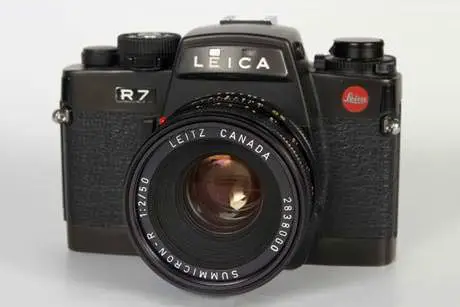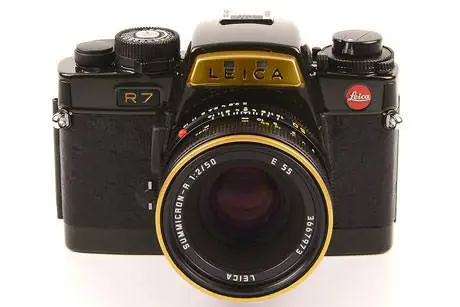Leica R7: a review
The R7 was Leica's SLR-camera of the mid-1990s. It was launched in 1992 and remained in production until 1997. It replaced the R5 and R-E in the R-system lineage of cameras, since the R6 and R6.2 as fully mechanical cameras represented deviations from the general development path of increasingly incorporating electronic features. Indeed, the Leica R7 was sold in parallel to the (more expensive) R6.2 throughout its entire lifetime.

The R7 was the first Leica with fully automated TTL flash control. It also added digital display of shutter speed in the viewfinder with backlighting, as well as automatic DX film sensitivity setting (with manual override). The additional electronics required that the camera's base be extended by 10.7 mm to create sufficient space for the components. The R7 is also about 45g heavier than its predecessors, but otherwise retains the body configuration of the R4/R5/R6, which in turn had been inspired by the Minolta XD-11 (XD-7 in Europe). The Leica R7 was available in black and silver chrome finish.
The R7 has a viewfinder with an eye-level, non-interchangeable prism, and a viewscreen that can be changed. The viewfinder covers 92% of the image area. Diopter adjustment is available in the range of +/- 2 units. The standard viewscreen has a coarse central microprism area with a central split-image focusing aid. The remainder of the screen consists of a matte focusing area. Viewing is at full aperture, with DOF preview. There are in-viewfinder displays for aperture, shutter speed, meter diodes, and meter pattern.

Four optional viewscreens are available for the R7: (i) a plain-ground glass screen for extreme close-up photography and shooting with very long focal lengths; (ii) a micro-prism screen to further facilitate composition; (iii) a full-field ground glass screen with a grip that is designed for architecture photography or document reproduction; and (iv) a clear-glass focusing screen for scientific photography, including astrophotography.
The shutter release and exposure meter of the Leica R7 rely on a 6V power supply, instead of 3V in previous R-series models. The camera, thus, requires four silver oxide button cells (each 1.5V) or two 3V lithium cells. If battery power is low, a "BC" symbol for "battery check" is displayed in the lower right corner of the viewfinder. If the batteries are completely flat, the camera can still function, but the shutter speed is limited to 1/100s or "B" (bulb).

Leica R7 Specifications
- Leica R bayonet mount;
- Focal plane, electronic, metallic curtain shutter; 1/2000s to 16s (4s in manual mode);
- Program, aperture priority, shutter priority, and manual exposure modes;
- TTL integrated or selective (7mm) exposure metering;
- Ground glass, interchangeable viewfinder screen;
- Hotshoe flash control; 1/100s, TTL-metering;
- External controls for battery self-check, eyepiece shutter, multiple-exposure, selective/integral exposure, DOF preview, self-timer;
- ISO range of 6 to 12800, automatic DX film speed recognition with manual overwrite;
- Exposure compensation from -3EV to +3EV (in half-stop increments);
- Film transport by manual lever; optional motor drive or winder;
- Compatible with the Leica Data Back DB2;
- Batteries: 4 x SR44 (LR44) cells or 2 x CR1/3N;
- Dimensions: 138.5 x 98.8 x 62.2mm (width x height x depth);
- Weight: 670g;
The R7 has two alternative metering modes: selective and integral. A switch beneath the shutter-release dial controls the choice. Metering is achieved through a photodiode placed in the camera base. The metering sensitivity ranges from EV 0 to EV 20 in integral mode, and EV 2 to EV 20 in selective mode. Full-field integral metering covers the entire view without any weighting of particular areas, while selective metering measures the incoming light only for the area that is indicated by the outer frame of the focusing circle, which has a diameter of 7mm. The metering choices are linked to the camera mode chosen. Integral metering is available in A, T, and P mode, and selective metering in A and M mode.
The camera has an electronically-timed, vertical-travel, metal shutter mechanism. The latter offers speeds from 4 seconds to 1/2000s in half-stop intervals in m and T modes, and continuously-variable speeds from 16 seconds to 1/2000 sec. in A and P modes. In addition, the R7 has a bulb mode ("B") for longer time exposures.
The R7 has an eyepiece shutter. The latter blocks stray light entering through the eyepiece, if the photographer's eye is away from the viewfinder. Hence, the camera's metering is not affected by light coming in from the back side.
One difference to the earlier R5 is that the R7 offers the possibility to lock-up the mirror. Hence, image blur from mirror slap during longer exposures can be avoided. The feature is activated by threading the Mirror Lock-up Release R (order number 14087), which is an optional accessory, into a small socket next to the lens mount.
The R7 offers fully automated TTL-flash control with an 1/100 sec X sync time. The camera has a flash hot shoe on top with contacts for SCA 350/351/550/551 compatible flash units. Fill flash is available with shutter-priority exposure mode, and the system will switch automatically between fill flash and full flash in Program mode.

| Camera | Shutter (1/sec) | TTL- metering | Exposure modes | Hot- shoe | Flash control | Size (mm) | Weight (g) | Prod run | Prod period | Price range ($) | ebay offers | ||
|---|---|---|---|---|---|---|---|---|---|---|---|---|---|
| 1 | Leicaflex | 2000 | - | M | No | non-TTL | 148.0 / 97.0 / 57.0 | 770 | ~32,500 | 1964 - 68 | 200-400 | check | |
| 2 | Leicaflex SL | 2000 | sel | M | No | non-TTL | 148.0 / 97.0 / 57.0 | 770 | ~75,000 | 1968 - 74 | 125-250 | check | |
| 3 | Leicaflex SL2 | 2000 | sel | M | Yes | non-TTL | 148.0 / 97.0 / 57.0 | 770 | ~25,000 | 1974 - 76 | 400-600 | check | |
| 4 | Leica R3 | 1000 | sel & int | A/S/M | Yes | non-TTL | 148.0 / 96.5 / 64.6 | 780 | ~70,000 | 1976 - 80 | 125-250 | check | |
| 5 | Leica R4 | 1000 | sel & int | P/A/S/M | Yes | non-TTL | 138.5 / 88.1 / 60.0 | 630 | >100,000 | 1980 - 87 | 150-250 | check | |
| 6 | Leica R4s | 1000 | sel & int | A/M | Yes | non-TTL | 138.5 / 88.1 / 60.0 | 620 | ~25,000 | 1983 - 87 | 150-250 | check | |
| 7 | Leica R5 | 2000 | sel & int | P/A/S/M | Yes | TTL | 138.5 / 88.1 / 62.2 | 625 | ~34,000 | 1986 - 91 | 250-500 | check | |
| 8 | Leica R6 | 1000 | sel & int | M | Yes | TTL | 138.5 / 88.1 / 62.2 | 625 | ~24,000 | 1988 - 92 | 400-550 | check | |
| 9 | Leica R-E | 2000 | sel & int | A/M | Yes | TTL | 138.5 / 88.1 / 62.2 | 625 | ~6,100 | 1990 - 94 | 450-600 | check | |
| 10 | Leica R6.2 | 2000 | sel & int | M | Yes | TTL | 138.5 / 88.1 / 62.2 | 625 | ~21,000 | 1992 - 02 | 500-750 | check | |
| 11 | Leica R7 | 2000 | sel & int | P/A/S/M | Yes | full-auto | 138.5 / 98.8 / 62.2 | 670 | ~30,000 | 1992 - 97 | 350-450 | check | |
| 12 | Leica R8 | 8000 | sel, int, multi | P/A/S/M | Yes | full-auto | 158.0 / 101 / 62.0 | 890 | ~36,500 | 1996 - 02 | 500-600 | check | |
| 13 | Leica R9 | 8000 | sel, int, multi | P/A/S/M | Yes | HSS | 158.0 / 101 / 62.0 | 790 | ~9,000 | 2002 - 09 | 1,000-1,500 | check |
Leica R7 FAQ
The R7 is not known for any major mechanical or electronic flaws, except that some users have reported that the shutter preview lever can become sticky or hard to operate. Also, the rubber seal that keeps light our of the film compartment might age over time and become brittle, requiring replacement. Otherwise, the R7 is a solid film camera classic. Below is some further information on some particular aspects of the camera.
What are the Leica order numbers of the different R7-versions?
Leica R7 (black): 10068; Leica R7 (chrome): 10202; Leica R7 (special edition "Partner Aktion Deutschland"): 10203; [leica-wiki].
How many R7 cameras did Leica produce?
About 30,000 cameras were produced and sold, of which about 7,000 had a chrome body finish.
How did the special edition "Partner Aktion Deutschland" differ from the regular R7?
The PAD-edition cameras, which were provided to Leica dealers in Germany as loaner models for prospective clients, had a map of Germany engraved on the viewfinder housing.
What is the R7 Urushi edition?
The Leica R7 Urushi Nihon Siber Hegner was a limited edition set (with Summicron 50mm) in dark green finish and Urushi paint. It was issued in 1995 to honor the 130th anniversary of the Japanese Leica dealer "Nihon Siber Hegner". Only 200 sets were produced.
Does the R7 work with ROM lenses?
Yes, the lenses can be mounted and work flawlessly, but – unlike the R8 and R9 – the R7 can not take advantage of the lens information passed through the electronic contacts.
Does the R7 make it possible to take multiple exposures?
Yes, multiple exposures are enabled by pushing down the rewind release button on the camera base after taking a shot.
Where can I get my R7 serviced and repaired?
Leica does no longer support R-system cameras. The company recommends to send cameras to Paepke-Fototechnik in Düsseldorf for any repairs.
Further Reading
Additional information on the R7 can be found in the pdf-version of the Leica user manual. Moreover, a description of the evolution of all Leica reflex cameras is contained in the R-system camera overview. A similar compendium of R-lenses with their main physical specifications is equally available on this site.
You are here: Home » Leica R Cameras » Leica R7